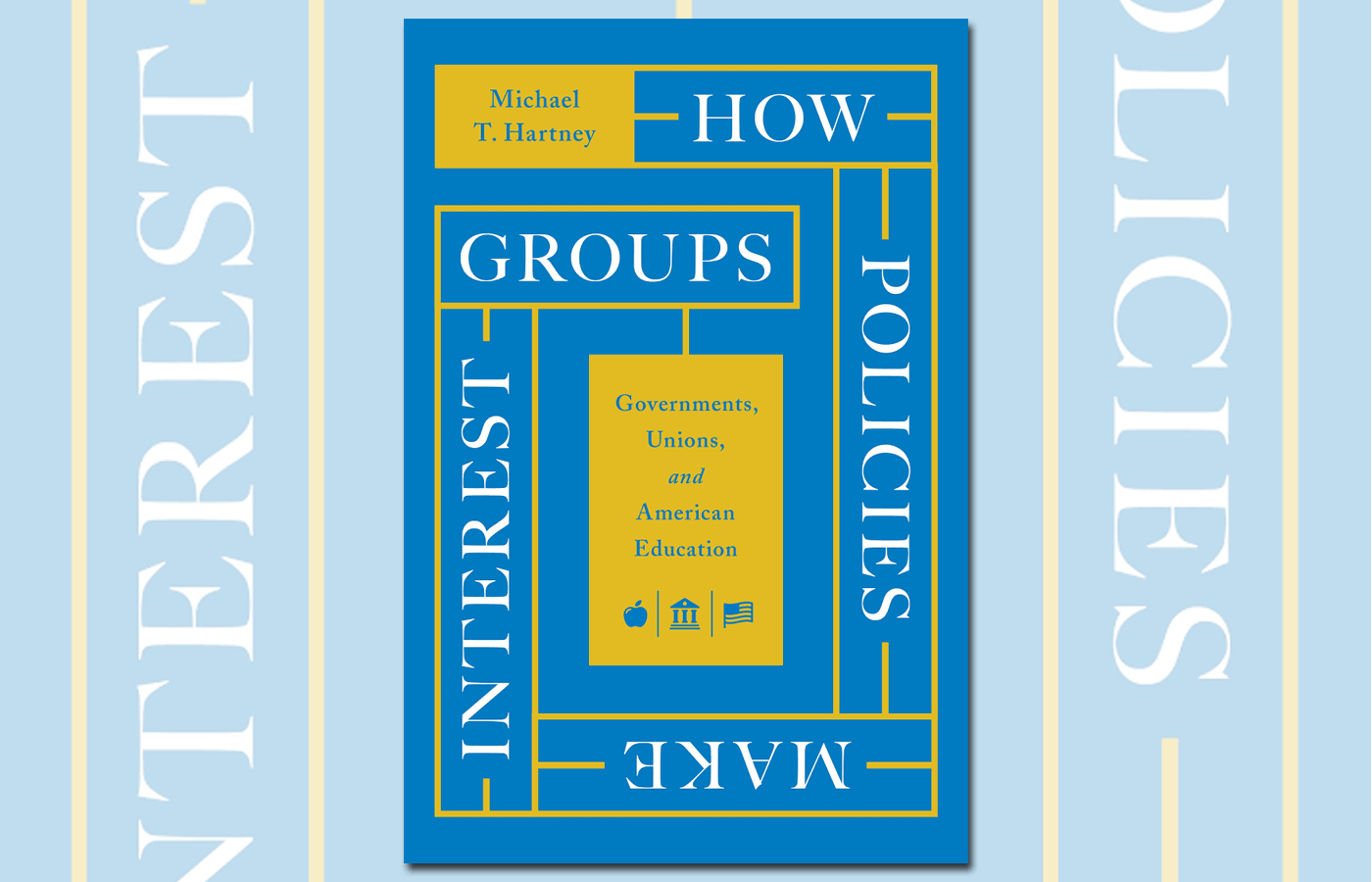
How Policies Make Interest Groups: Governments, Unions, and American Education
by Michael T. Hartney
University of Chicago Press, 2022, $35; 312 pages.
As reviewed by Daniel DiSalvo
During the Covid-19 pandemic, school districts with strong teachers unions were slower to bring students back to the classroom than districts with weaker unions were. Controversy over the unions’ power to determine the mode of instruction capped off a decade in which teachers unions were the most polarizing aspect of American education politics. School reformers blame them for blocking changes to improve public education; union advocates argue they defend teachers, improve conditions for students, and prop up the labor movement.
In a new book, How Policies Make Interest Groups, Michael T. Hartney makes a courageous but careful foray into the highly charged debate over the causes and consequences of teacher unionization in America. Regarding the causes, he traces how state labor laws impelled teachers from being a politically disengaged group to becoming a “potent force in American politics.” In short, state governments created modern teachers unions. As for the consequences, Hartney argues that teachers unions have blocked many of the initiatives of the bipartisan education-reform movement and largely succeeded in preserving the traditional organization of most public schools. He also finds evidence that union political clout “can reduce [student] academic performance.” Recently, teachers unions have suffered a few setbacks, such as the U.S. Supreme Court’s 2018 Janus decision, which prevents unions from exacting fees from nonmembers and has led to declines in membership. Yet despite such obstacles, Hartney argues that teachers unions will remain powerful players in education politics. (Disclosure: I co-authored an essay with Hartney for Education Next that was a first cut at this last claim. See “Teachers Unions in the Post-Janus World,” features, Fall 2020.)
Drawing on a wealth of data, How Policies Make Interest Groups is a statistically sophisticated study of the role of teachers unions in education policy. Hartney pulls from a number of sources, especially the National Education Association’s extensive historical records, along with his own surveys, the American National Election Study (ANES), contract data from the National Council on Teacher Quality, National Assessment of Educational Progress (NAEP) scores, public records from a variety of states, and much more. He tries mightily to support nearly every claim with the best data available, all the while being candid about the data’s limits.
The first half of the book details the remarkable transformation of teachers from a politically disconnected group in the 1950s to a political powerhouse by the 1980s. In the 1950s, teachers did little politically besides vote, according to ANES surveys. By the 1980s, the teachers unions had established PACs in all 50 states and were sending more delegates to the Democratic National Convention than the state of California was. The change was sparked, according to Hartney, by new state collective-bargaining laws, which created an ensemble of “subsidies” that facilitated union organizing. By “organizing all teachers in a school district into a single employee bargaining unit,” Hartney writes, the new laws “made it both logistically easier and financially less costly for unions to recruit teachers to participate in politics.” Collective-bargaining agreements negotiated under the new laws established a host of privileges that facilitated union recruitment and the political mobilization of teachers. These benefits included free use of school buildings and equipment; access to teacher contact information, school mailboxes, and bulletin boards; presentation time at faculty orientation; and paid release time for teachers to work on union business.
The results were a major uptick in political activity by both individual teachers and their union organizations. After collective-bargaining laws went into effect, teachers—and only teachers—reported to the ANES a large increase in their willingness to participate politically. This is because the new laws solved the unions’ collective-action problem, creating organizations with stable memberships and revenues that could mobilize teachers. For instance, the NEA could unify its membership into a national federation and raise dues without losing members—something many other membership organizations have tried and failed to do. State labor laws thus created a “massive federated interest group capable of coordinating political action in fifty states and thousands of school districts.”

The second half of Hartney’s book examines effects of teachers unions as government-made interest groups. He shows how teachers and their unions strategically prioritize state politics for voting, lobbying, and campaign contributions. The unions give 90 percent or more of all PAC contributions in state politics made by education advocacy groups. Teachers and their unions are also very successful in school board elections—nearly a quarter of all school board members are current teachers or former educators. Because teachers unions are almost always more politically powerful than their opponents, elected officials have strong incentives to pay attention to union demands.
To assess how power translates into policy, Hartney provides a “scorecard” of the consequences of teachers union political activity. It shows that when teachers unions are on “offense,” trying to win things for their members, their record is mixed. They’ve clearly won some things they wanted, such as establishing a federal department of education. They’ve clearly lost on other things, such as the enactment of a federal public-sector collective-bargaining law. Meanwhile, they’ve had some success reducing class size and raising teacher pay (despite these two goals being in tension). However, when the unions are on “defense,” trying to block changes deemed antithetical to their interests, they are much more successful. Teachers unions have mostly thwarted efforts to impose teacher testing, merit pay, and school vouchers, as well as moves to alter tenure and seniority rights. Reformers have won some victories here and there (most notably in Washington, D.C., and New Orleans) and have had some success in creating charter schools. What’s more, the federal government now requires schools to test students in grades 3 through 8 every year and make the results transparent at the school level. But in most of the country, public schools operate pretty much the same way they did 30 years ago.
The biggest question is what it all means for kids. Sometimes teachers unions’ interests jibe with students’ interests, but sometimes they don’t. Hartney takes a stab at the most difficult and controversial topic: assessing whether union influence lowers student performance. As he stresses, the data and measurement problems of such assessments are formidable. Therefore, any results should be treated cautiously. And yet, when Hartney analyzes better measures of union power and student achievement than previous studies used, he finds that “states made less progress on the NAEP when organized teachers interests wielded greater resources in state politics.” His findings are congruent with more-methodologically sophisticated recent scholarship than with older studies that found the teachers unions had either no impact or a slight positive impact on student learning.
All told, Hartney has written a meticulous, nuanced, and thoughtful book that should be read by anyone who cares about public education in the United States. Readers on all sides of the education-policy debate will find support for their views in it. Supporters of teachers unions will find evidence that the unions are pretty good at advancing members’ interests, such as smaller class sizes and higher pay, and at blocking reforms championed by billionaire philanthropists. Critics of teachers unions will find evidence that their political power obstructs efforts to improve America’s public schools and that it may lead to lower student performance at higher cost.
Whether this book will prompt readers to revisit their prior convictions is hard to say. But Hartney’s fine-grained empiricism cuts through much of the cant and hyperbole in debates over the role of teachers unions in education policy. In that respect, among many others, it is big step forward.
Daniel DiSalvo is a professor of political science at the City College of New York-CUNY and a senior fellow at the Manhattan Institute.
This article appeared in the Spring 2023 issue of Education Next. Suggested citation format:
DiSalvo, D. (2023). How Teachers Unions Became a Political Powerhouse: A nuanced look at the role of unions in education policy. Education Next, 23(2), 69-70.


